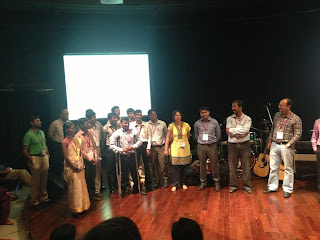As Meghraj walked on to stage confidently to tell his story,
the audience watched, and then listened mesmerized. If his story of moving from
doing casual physical labour across India to working in a BPO for a major IT
company was captivating in itself, the fact that he told the story in fluent
English gave it the romantic touch of Eliza Doolittle. How did this
transformation of a primary school dropout to an IT services professional
happen? That’s the story of Head Held High (HHH).
Henry Higgins was able to transform one flower girl into a
high society English woman. In keeping with the times, and the challenges we
face today, HHH has much more audacious goals. In the next decade, the
organization hopes to take 2 million Indians out of poverty.
Inspired by an Interesting Medley of Thinkers
HHH is inspired by an unorthodox yet attractive mix of
thinkers. Their first source of inspiration is, of course, Mahatma Gandhi. The
Mahatma’s great grandson, Tushar Gandhi, is on the board of HHH, and he gave an
inspiring talk at the HHH event I attended a week ago. Drawing on stories from
Gandhiji’s life, Tusharji emphasized the importance of humility (learn from
others rather than thinking you have something to teach them), action (based on
the fascinating story of the Dandi Salt March, and how it was first opposed by
Motilal Nehru and others), and a spirit of service (“we are privileged to have
the opportunity to serve”).
HHH’s second inspiration (maybe I should call it the first?)
is Rabindranath Tagore. His moving poem, “Where the mind is without fear” remains
one of the few that I remember from my school days. HHH’s name comes from the
first line of this poem, and signifies the mission of the organization to help
every Indian live with dignity. I can’t think of a better way of putting it.
HHH’s third inspiration is our former president, APJ Abdul
Kalam. One of Mr. Kalam’s favourite projects has been PURA, providing urban
amenities in rural areas. The PURA philosophy seeks to prevent large scale
migration to urban centres, and to allow people to live closer to their roots.
That’s undoubtedly difficult to achieve, and goes counter to the way today’s
developed nations evolved, but offers an alternate, and attractive model of
development. HHH hopes to create a network of globally-connected rural
ecosystems in line with the PURA philosophy.
A management guru completes the quartet. During his three-decade
professional career, CK Prahalad covered amazing ground from strategic intent
to core competence to the idea he is best known for today – the fortune at the
bottom of the pyramid. Though CK’s first formulation of this idea focused on
the poor as consumers, after some robust criticism by Aneel Karnani and others
he broadened its scope to include the poor as key economic actors. It is this
latter notion that is strongly embedded in the HHH model.
The HHH Model
At the core of HHH, is a powerful training engine. HHH has
developed intensive training methods that allows them to transform non
English-speaking, school dropouts from rural backgrounds into qualified and
confident English-speaking individuals who can join the global workforce. The
training is completed in a residential boot camp at a district headquarters
town. It’s a tough course – long days, and very little time off - but the
outcome is undeniably good.
But HHH’s goal is not to send more people from rural India
into our crowded cities. Instead, it seeks to find them good jobs close to home.
HHH has worked closely with rural BPO service provider partners to find jobs
for the people it trains. But HHH soon came up against a major challenge –
rural BPO accounts for less than 1% of those employed in the BPO industry.
Large corporations are uneasy about using rural BPO services fearing
difficulties in control and oversight, and hence quality control. HHH has
worked on some technological solutions to this problem including android
platform based dashboards that allow the client to monitor key output and
quality parameters in real time. This has helped ease client concerns.
The Bigger Picture
Of course, BPOs can’t be the only solution to the challenge
of creating rural jobs. HHH understands that there need to be many other
employment opportunities created. One opportunity has already been discovered
in doing rural market surveys. Helping FMCG and other companies penetrate
beyond the block level through last mile rural distribution is another
possibility. But, creating all these opportunities can’t be a centralized
process.
Another prong of HHH’s efforts is therefore to train rural
entrepreneurs. If organizations like TiE can catalyse entrepreneurship in urban
India, can’t something similar be done in rural India? HHH held an
entrepreneurship workshop in Gadag last year – I saw the picture of a packed
hall – and hopes to train high potential entrepreneurs from rural India (some
of HHH’s top management, including CEO Madan Padaki come from an assessment
background; this should help them identify these people!). But I was a little
worried that I didn’t see a single woman either on the dais or among the
participants in that Gadag event.
Ultimately, HHH plans to be the catalyst of rural ecosystems
that generate jobs, sales and rural wealth. In a globalized world, these rural
ecosystems will be connected to each other, and to bigger ecosystems elsewhere.
This will be the modern version of
Gandhiji’s village economy, consistent with many of his principles, but aligned
with the contemporary world.
HHH’s journey so far includes innovation in training methods
and technology. It is likely that many more innovations will be required to
make their dream come true. I will be watching them in anticipation…


































Thanks for the writeup on HHH -- I've followed them avidly since interviewing them for a documentary since '10.
ReplyDeleteQuestion for you: How would you personally define "jugaad"?